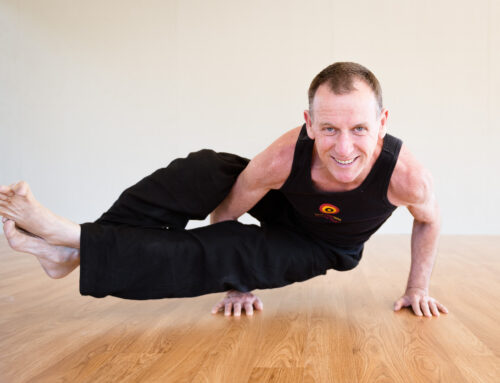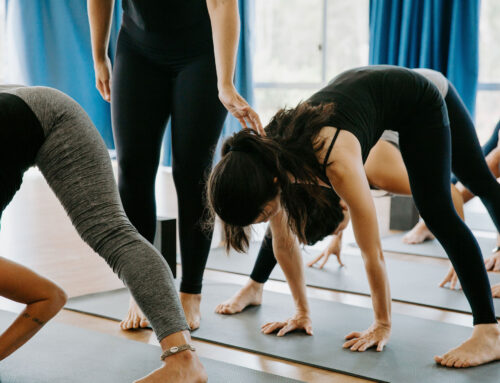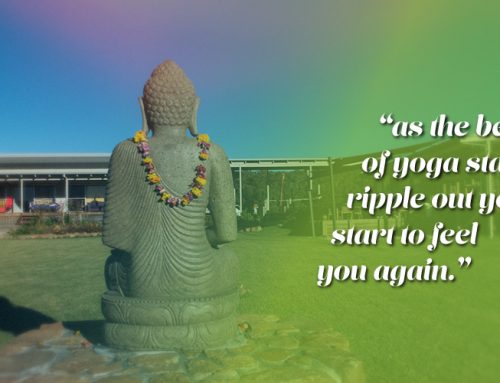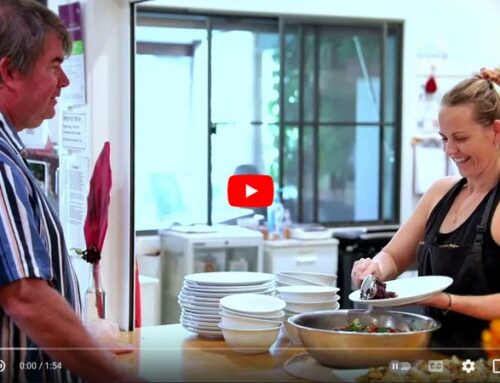Written by Ana Davis
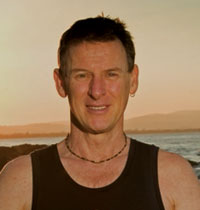
Nowadays John is one of Australia’s most respected and experienced teachers, and founder of Byron Bay’s long-time yoga school, Byron Yoga Centre. He heads up a popular teacher training program at the school, attracting students from around the world, who come to learn from his 20 years of teaching experience. However, there was a time when he had no money, no friends and very little self esteem; when his spirit was so impoverished he attempted to take his own life.
When I ask him to reflect on his life so far, he expresses a feeling of it being ‘quite polarised’, like two completely separate lives: the life before he went into the drug-rehabilitation program at the Buttery in Byron Bay, and the life since.
We begin with his ‘first life’, spooling back about 40 years to the leafy, middle class suburb of Glen Waverly in Melbourne, when John was a shy, insecure teenager who started drinking alcohol at the age of 12. “I felt like I didn’t fit in. So getting ‘stoned’ or intoxicated made me feel different, that everything was OK,” he remembers. “It also gave me a social group to fit in with”.
The weekend drinking at football games become more regular, and as he approached his mid-teens he started experimenting with other drugs – marijuana and ‘pills’, speed, acid and other hallucinogens like ‘magic-mushrooms’.
It was during his school years that he exhibited his propensity to live parallel and seemingly contradictory lives that would be echoed later in his life. Having been brought up a Catholic five days a week, he applied himself assiduously to the role of Altar Boy. Although he embraced the Catholic faith, he had also worked out that he could break the rules, for example, eating sweets during Lent, and no one would ever know. From his late teens, he rejected Catholicism to explore alternative philosophies, and an overall belief in ‘hedonism’ that helped justify his drug-taking lifestyle.
When John was about 19, there was a ‘drought’ of marijuana, so his supplier offered him heroin. This was his first taste and he remembers it as a ‘lovely, pleasant’ experience. It wasn’t too long before it became his drug of choice. It was the late 1970s, towards the latter part of the Vietnam War, and there was an outbreak of plentiful and cheap heroin in Australia from South East Asia.
This heralded the beginning of a relentless cycle that would have John in its grip for the next 10 years. He would see-saw between all-consuming heroin use and the methadone substitute. On the methadone program, he would be able to get his life back on the rails for a time, and work his trade as an electrician. “I couldn’t imagine a life without drugs,” he says. “I thought it was a matter of learning how to use drugs manageably”.
In his early 20s, in an attempt to break the cycle, he went to work in Saudi Arabia, a drug-free country, where he lasted for nine months. During his time there, reflecting his tireless spiritual search, he adopted the religion of Islam, visiting the mosques five times a day. “My life for that 10 years became a pattern of using people, places and things to try to change the way I felt” John reflects. “At the same time, blaming people, places and things for all of my problems.”
There were periods when he would manage to get off even the methadone, but his pattern was to drink, and smoke marijuana during his so-called ‘drug-free’ periods. After a while, he’d miss the euphoric effect of his drug of choice, heroin. “I would feel lonely. There was an emptiness there,” he says. “In the end I’d think – ‘oh I’ll just use it one time’”.
In this way, it would creep back into his life again, and within a few weeks he was back using every day, and within a couple of months, he would have squandered all his savings and his life would have ‘taken a dive again’.
Each time John would hit a ‘rock-bottom’ it would be incrementally worse than the previous one. Initially it was just a ‘financial rock-bottom’, over time it became a combination of a ‘mental, emotional, physical rock-bottom’. “Without realising it, I was also hitting a spiritual rock-bottom as well”, he says.
He started to do more desperate things to support his habit. He ‘hocked’ everything he owned. He realised then it was only a small step to start stealing from people and hocking the stolen goods as well, and then it wouldn’t be long before he could see himself getting caught and sent to prison. “I came to see just how bad my life was,” he recalls. “Whenever I’d meet someone, I’d think – ‘what do you want from me? And what have you got that I can get from you?’ – that was my whole way of relating to people.”
It was at this lowest of ebbs that John made a ‘conscious decision’ to terminate his life by taking an overdose. “I was nothing but a burden and a pain on anyone and everyone around me,” he says. “So I decided to finish it, it was in the best interests of everyone, including myself”.
In an inner city motel, John took an overdose of heroin and sleeping pills. Three days later he woke up in St Vincent’s hospital after having been in a coma. “When I woke up … even though I could open my eyes, I couldn’t move and I couldn’t speak,” he recalls. The following day he was able to make unintelligible sounds. “I remember I had this fear that this was as good as it was going to get. That I was this ‘vegetable’ that could make these sounds that no one could understand”.
Fortunately, John did recover. He was deemed well enough to be admitted to a detoxification centre in Melbourne. It was there at the ‘Pleasant View’ Centre, at 23 years of age, that he was first introduced to yoga. “There was a guy who had a few photocopied sheets of yoga poses”, he remembers. “And he used to take us out into the garden and we would do a few postures”.
When John left the detox centre he took with him a copy of these ‘foolscap sheets of paper’ detailing some very basic yoga movements. He started a daily practice of about 2 hours. This however was still not enough to fill a ‘huge, black hole of emptiness’ that he experienced whenever he was drug free. So, it wasn’t long before he starting using marijuana, alcohol and then the ‘occasional heroin’ again.
John then admitted himself to another detox centre where he was introduced to Satyananda Yoga. His interest in yoga was now well and truly sparked. When he left the detox centre, he started ‘shopping around’ – soaking up all and every style of yoga, in classes around Melbourne, from Rajneesh to Siddha Yoga. A turning point in his journey in yoga was an introduction to Iyengar yoga through an Adult-Education course he attended.
I ask John what it was about yoga that first captured his imagination. “I had justified my drug use because I had always felt so stressed out, so stressed with life”, he responds. Yoga began to offer an alternative way for him to release his stress. He became obsessed with yoga, practicing 6–8 hours a day.
“But yoga wasn’t really helping me with the issue of the ‘black hole’ in my life,” he analyses. “You can only do the Asanas (postures) for so many hours in a day. I look back on it now and see that type of activity as avoidance – a distraction from really working on the issue of healing the ‘black hole’.”
In response to his ongoing search to fill this spiritual vacuum, John discovered the 12 Step Program through A.A. (Alcoholics Anonymous) and N.A. (Narcotics Anonymous) meetings. He also became increasingly involved with the Hare Krishna community in Melbourne, until eventually he moved into their Ashram. “The Hare Krishnas were like family to me,” he says. “They basically looked after all of my physical needs”.
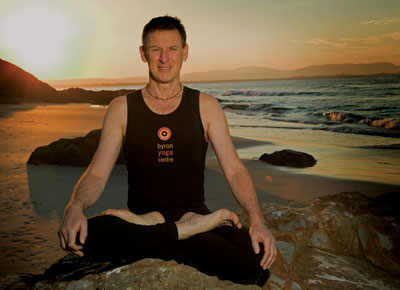 At the time, he thought his association with the Hare Krishnas was a natural continuation of his interest in yoga. However, their philosophy was that Asana (the yoga postures) practice was unnecessary, so he stopped his physical practice of yoga. Instead, he practiced the Bhakti (devotional) yoga and Karma (service) yoga as a resident in the Ashram. For the next four years, his time was divided between doing chores at the ashram, working at the Krishna Drop-in centre and soup kitchen, and chanting and meditating.
At the time, he thought his association with the Hare Krishnas was a natural continuation of his interest in yoga. However, their philosophy was that Asana (the yoga postures) practice was unnecessary, so he stopped his physical practice of yoga. Instead, he practiced the Bhakti (devotional) yoga and Karma (service) yoga as a resident in the Ashram. For the next four years, his time was divided between doing chores at the ashram, working at the Krishna Drop-in centre and soup kitchen, and chanting and meditating.
Non-fortuitously, the Ashram was located in Melbourne’s notorious St Kilda, so it wasn’t long before he felt tempted to seek out heroin again. John then established a ‘schizophrenic lifestyle’, which continued for several years, secretly taking drugs while living in the Ashram. “I felt all of the guilt about pretending that I was living a good clean lifestyle with the other Hare Krishnas,” he recalls. “Then, when I was with the drug people, thinking I was superior to them because I was actually living this spiritual life away from scoring and using the drugs with them”. This ‘separatist’ pattern was only curtailed when John accidentally overdosed in the toilets at the Hare Krishna Ashram, and they asked him to move out.
In 1986, at the age of 29, after unsuccessfully undergoing two more short-term detoxification programs in Melbourne, he was finally referred to the Buttery Centre in Byron Bay. It was here that his passion for yoga was re-ignited. He took advantage of the in-house yoga classes offered there. He also practiced yoga in the early mornings with a staff member and local yoga teacher, Jenny Groves, who had recently trained with Martyn Jackson.
After so many previous failed attempts to fight his addiction, it was the Buttery that offered the winning formula for John. It was thanks to the longer, 5 month residency there, that the pieces finally all came together for him, and he has now remained ‘clean’ for the past twenty-two years.
This brings us to John’s ‘second life’. After completing his time at the Buttery, he moved to Sydney, where he obsessively attended classes at the Action School of Yoga, and apprenticed to Diane Currie. He also religiously attended daily N.A. meetings to continue to support his new, healthy lifestyle. John then decided to make the ‘sea change’ back to Byron Bay, where he apprenticed with Jenny Groves at her yoga school. By 1987, he felt ready to open his own school, the Byron Yoga Centre.
I ask John what it was about yoga that helped bring about the long-term healing of his addiction issues. “The Asanas are one aspect of yoga,” he explains. “They helped maintain my physical health and positive attitude.” He adds that the study of yogic texts, such as the Bhagavad Gita, also taught the values of temperance and balance, which he then endeavoured to embody in his life.
John also credits the ‘12 Step Program’, which is employed in drug rehabilitation programs, with providing him with a fundamental “belief in a higher power that is loving and caring”. “A loving power that gives me what I need when I’m ready for it, not what I want, when I want it,” he stresses. It is this belief that offers him the comforting awareness that “there is nothing to be afraid of”, that there is no coincidence in anything that happens in his life.
By integrating the spiritual guidelines of the 12 step program with the practice and philosophies of yoga, John has succeeded in ‘healing the hole’ that had haunted him since his teens. “By living these principals in all my affairs, helped the hole, slowly over a period of years, to close and heal,” John says. “Even now, there is a sensitive scar where the hole had been.” When asked for a concrete example of this ‘scar’, he attests that his tendency towards ‘obsessive compulsive’ behaviour provides a wake-up call. “I see it as a healthy reminder, that it’s really important to maintain my sadhana – regular practice of meditation, pranayama, asana and study”, he concludes.
John also attributes a stable home life with his wife of 12 years, Michelle, and their daughter, Shaani, to providing balance and nourishment in his life.
After his own long, personal journey, John now finds ways to give back to the community. He is a Board Member of the Buttery and ensures the weekly yoga class at the Buttery continues under the tutelage of one of his teacher training graduates. He also runs regular fundraising classes and workshops at his yoga centre from which all the profits go to the Buttery, Rainforest Rescue and Food for Life charities.
Offering young people the kind of positive mentorship he never had at their age, he provides a welcoming and non-judgmental place for ex-residents of the Buttery to nurture their interest in the yoga lifestyle, encouraging them in the weekly classes and teacher training courses.
When Davina, an ex-resident of the Buttery, was first introduced to John’s Centre she admits she was, at first, intimidated by him, until she found out about his own story of recovery from long term addiction. “I realised I could feel safe at his yoga centre,” Davina says. “It was inspiring to me that as an addict, John can come from ‘nowhere’ to where he is today.”
Davina, who is an ex-model, recovering from over a decade of living the ‘fast life’ in Sydney, says she feels supported by John and her ‘substitute family’ at the Centre. She has worked hard to become one of John’s senior teachers, helping with the teacher training courses. “When I need to talk about anything related to recovery I can go to John,” she says. “John’s become my teacher and has totally looked after me.”
Fellow yoga teacher and high-powered lawyer and ex-party girl, Kara, agrees that John inspired and supported her in her new, drug-free life. “I was totally drawn to him. He has the most warm, open heart that I’ve come across …” she enthuses. “…compassion and kindness and all the qualities I wanted to embody.”
Kara relates to John’s light, joyful teaching style, laughing her way through his classes. “He creates a space that encourages his students not to take themselves too seriously,” she says smilingly. “He always says yoga ought to be performed joyfully, or not at all!”
It is in this spirit of infectious joy that John and this team work to carry out his
self-declared mission of “spreading yoga into every town and every village on the planet”. If the challenges that John has overcome in his past are anything to go by, I think he might just succeed!
This interview originally appeared in Australian Yoga Life magazine.
